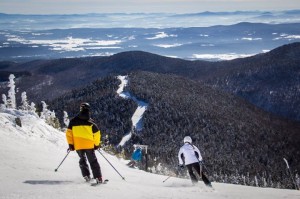Martinsville, NJ – With the winter season now underway, many skiers are preparing to hit the slopes in full force. A look back at the 2014-15 season reveals that skier visits dropped by 5%, from about 55.7 million to 53.6 million, according to the National Ski Areas Association (NSAA). On a region by region basis, skier visits slipped slightly in the Northeast and Rocky Mountain regions, while plummeting in the Pacific Southwest, Midwest, and the Pacific Northwest due to weather conditions. On a brighter note, both Whistler Blackcomb in British Columbia, Canada, and Vail Resorts, a major owner and operator of resorts in Colorado, Utah, and California, saw revenue per total visit increase despite lower skier visits thanks to intense marketing initiatives. With Mother Nature already beginning to comply with winter weather, Ken Schapiro of Condor Capital Management sees some of last year’s trends reversing and is optimistic for a strong ski season ahead.
First and foremost, recent data released by the National Oceanic and Atmospheric Administration (NOAA) show that this year’s El Niño pattern (a term used to describe the fluctuation in sea-surface temperatures taking place in the tropical Pacific Ocean) will be one of the strongest on record. According to NOAA models, the Pacific Northwest is expected to have a much drier-than-usual winter, while Colorado, the Rockies, and drought-stricken California are predicted to have higher-than-usual levels of precipitation. As of late, the above-mentioned predictions have been accurate, with ski resorts across California enjoying their earliest opening since 2012, owing to above-average snowfall in the Sierra Nevada Mountains. Similarly, resort officials across Colorado have indicated that this season has had its best start in 11 years.

With weather cooperating, economic indicators are pointing towards an increase in consumer spending, as well as a healthier overall economy. With oil prices trending at relatively low levels, individuals are saving around $700 per year on gasoline, according to the Energy Information Administration. Of this, they are spending 78 cents of every saved dollar on categories like entertainment, electronics, and appliances, based on research done by the J.P. Morgan Chase Institute. With consumer optimism high, it is anticipated that U.S. retail sales will grow 4.0% for the holiday period compared to 2014, according to MasterCard SpendingPulse. Amidst positive economic data, the hope is that this will translate into a robust ski season for the upcoming year.
According to SnowSports Industries America (SIA), retail sales in the snow sports market during the 2014-15 season came in at $4.5 billion, up 2% from the prior year. Specialty shop sales fell 4% to $2.35 billion, while chain store sales and online sales rose 13% and 4%, respectively, to $2.2 billion and $997 million. In all sales channels, outerwear sales were up 9% to $1.8 billion and accessories were up 4% to $1.2 billion, while equipment sales fell by 7% to $817 million. With a general upward trend in retail sales over the past several years, Condor Capital Management expects sales growth to continue on a steady pace going forward.
Although both weather and economic fundamentals appear to support a solid year, many resorts have been taking initiatives to protect themselves from unforeseen events, including significant upgrades to snowmaking infrastructure, as well as expanding their activities with off-season offerings including zip lines and mountain biking.
Resorts have also been shifting their focus on high-net worth individuals. Data by the NSAA show that about 58% of ski resort visitors during the past season lived in households making upwards of $100,000 a year; this is up from 45% during the 2006-2007 season. As a result, Vail Resorts has opened the White Carpet Club at its Beaver Creek Resort in Colorado to appeal to its wealthy visitors, many of whom have an average yearly household income of about $300,000, according to the Chief Marketing Officer of the company. With resorts continuously vying for visitors, the above-mentioned trends are likely to become more prevalent this season.
A rise in the global “sharing economy” has recently led vacation rental sites, such as VRBO and AirBnB to gain ground among travelers. For instance, one in four individuals stayed in a private accommodation in 2014, up from one in ten in 2011, according to travel industry research firm Phocuswright’s annual survey. Moreover, vacation rental marketplace HomeAway has indicated that the number of vacation-rental listings in Colorado has been growing from 9% a year to more than 20%. As is the case, listings in Steamboat Springs, Colorado grew 175% from 2009-2014. We expect resort visits to benefit from the growth in private lodging sites, such as AirBnB, as they offer an additional source of distribution and a way of improving occupancy in “lukewarm beds” — those that are used between four and twelve weeks each season.
Despite several tailwinds for the upcoming ski season, the pace of winter bookings at many Western resorts has slowed by 2.3% according to DestiMetrics, a Denver-based firm that analyzes 290 property management companies across Colorado, Utah, California, Nevada, Oregon and Wyoming. Nonetheless, with resorts opening their doors sooner than expected, Schapiro believes that last-minute bookings will be strong and counteract this trend. Moreover, an increasing influx of international travelers into the United States, especially from emerging markets such as China, should increase revenue per total visit at many resorts. With that said, Condor Capital Management is expecting skier days to grow 3-4% in the upcoming season.

